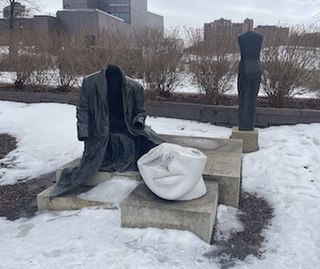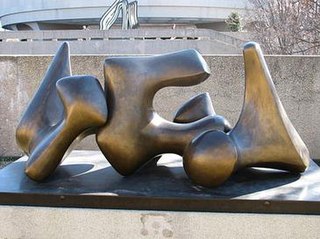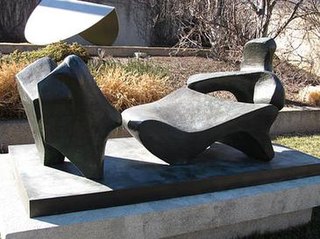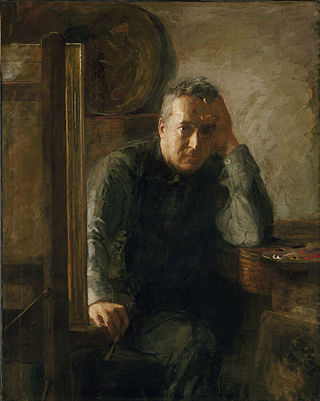
The Hirshhorn Museum and Sculpture Garden is an art museum beside the National Mall in Washington, D.C., United States. The museum was initially endowed during the 1960s with the permanent art collection of Joseph H. Hirshhorn. It was designed by architect Gordon Bunshaft and is part of the Smithsonian Institution. It was conceived as the United States' museum of contemporary and modern art and currently focuses its collection-building and exhibition-planning mainly on the post–World War II period, with particular emphasis on art made during the last 50 years.

Joseph Herman Hirshhorn was an entrepreneur, financier, and art collector.

Robert Engman was an American sculptor with works in the permanent collection of the Hirshhorn Museum, MOMA, the Whitney Museum of American Art, numerous college museums, and private collections.

Judith Shea is an American sculptor and artist, born in Philadelphia, Pennsylvania, in 1948. She received a degree in fashion design at Parsons School of Design in 1969 and a BFA in 1975. This dual education formed the basis for her figure based works. Her career has three distinct phases: The use of cloth and clothing forms from 1974 to 1981; Hollow cast metal clothing-figure forms from 1982 until 1991; and carved full-figure statues made of wood, cloth, clay, foam and hair beginning in 1990 to present.

Throwback is a public artwork by American artist Tony Smith, located at the Hirshhorn Museum and Sculpture Garden in Washington, D.C., United States. This version is the third of an edition of three in the series with one artist's proof.

Needle Tower is a public artwork by American sculptor Kenneth Snelson located outside of the Hirshhorn Museum and Sculpture Garden in Washington, D.C., United States.

Are Years What? is a sculpture by American artist Mark di Suvero. It is in the collection of the Hirshhorn Museum and Sculpture Garden, in Washington, D.C., United States. The sculpture is named after poet Marianne Moore's "What Are Years". From May 22, 2013 through May 26, 2014, the sculpture resided temporarily in San Francisco, as part of the San Francisco Museum of Modern Art's Mark di Suvero exhibition at Crissy Field.

Three-Piece No. 3: Vertebrae is a bronze sculpture by Henry Moore. It was cast in 1968 as in edition of 8, along with an artist's copy which is now part of the Tate collection.

Three-Piece Reclining Figure No. 2: Bridge Prop is a sculpture by Henry Moore, created in 1963, and produced in an edition of six copies.

The Back Series is a series of four bas-relief sculptures, by Henri Matisse. They are Matisse's largest and most monumental sculptures. The plaster originals are housed in the Musée Matisse in Le Cateau-Cambrésis, France.

Lunar Bird is an abstract bronze sculpture by Joan Miró. It was modeled in 1945, enlarged in 1966, and cast in 1967.
Draped Reclining Figure, 1952–53 is a bronze sculpture by Henry Moore, catalogued as "LH 336".

José Ruiz de Rivera was an American abstract sculptor.

Curved Form (Bryher) is a bronze sculpture by Barbara Hepworth, modeled in 1961.

Hotel by a Railroad is a painting completed in 1952 by the American realist painter and printmaker Edward Hopper. The work is an oil on canvas, measuring 101.9 x 79.3 cm. It resides in the collection of the Hirshhorn Museum and Sculpture Garden.

Arcadia is a c.1883 painting by Thomas Eakins, Goodrich #196. It is part of the collection of the Metropolitan Museum of Art.

Charles Bregler was an American portrait painter and sculptor, and a student of artist Thomas Eakins. Bregler wrote about Eakins's teaching methods, and amassed a large collection of his minor works, memorabilia and papers. Following Bregler's death, his widow safeguarded the Eakins collection for decades before selling it to the Pennsylvania Academy of the Fine Arts.

Standing Figure: Knife Edge is a bronze sculpture by the English artist Henry Moore. It was cast in two full-size versions: Standing Figure: Knife Edge in 1961, and a larger Large Standing Figure: Knife Edge in 1976. The sculpture also is sometimes known as Standing Figure (Bone) or Winged Figure.
















